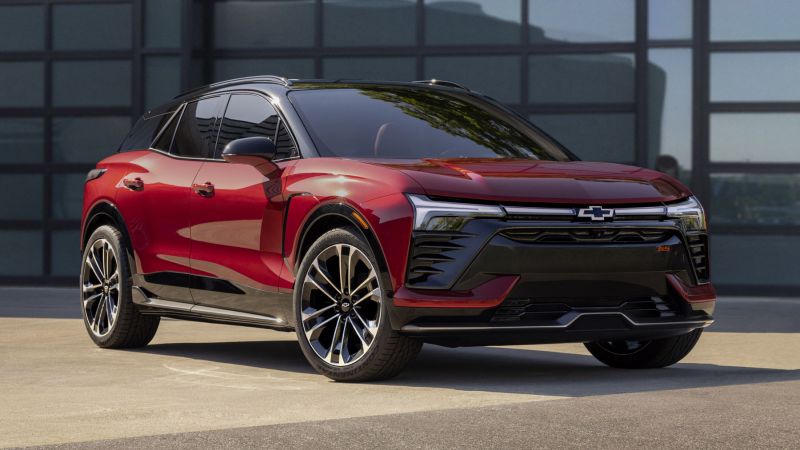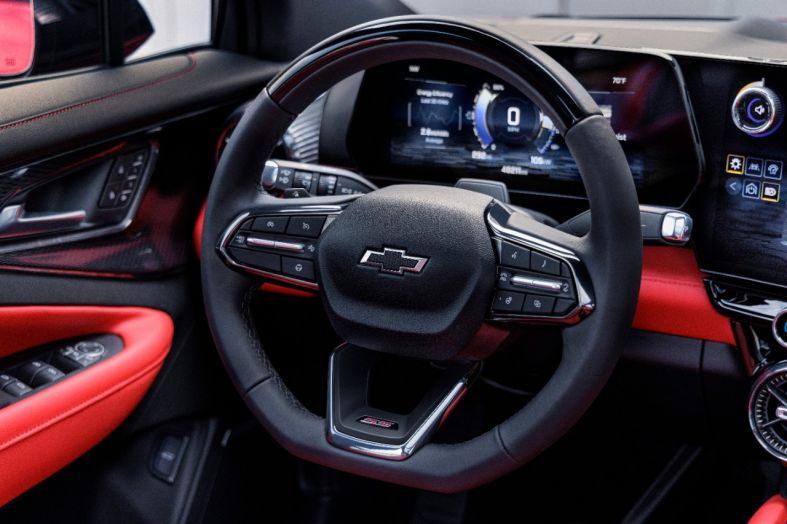GM's New Blazer EV Will Take on the Tesla Model Y Performance and Ford Mustang Mach E
【Summary】General Motors officially revealed the new 2024 Blazer EV last night, which marks the company’s first entrance into the popular mid-size electric crossover segment that’s currently dominated by Tesla’s Model Y, the Ford Mustang Mach E and Hyundai IONIQ 5, along with dozens of other gas-powered models.

General Motors officially revealed the new 2024 Blazer EV last night, which marks the company's first entrance into the popular mid-size electric crossover segment that's currently dominated by Tesla's Model Y, Mustang Mach E and Hyundai IONIQ 5, along with dozens of other gas-powered models.
For EV buyers looking for an alternative to a gas-powered SUV, the new Chevy Blazer EV may fit the bill. The electric Blazer is a completely new vehicle and does not share its chassis with the gas-powered version.
The launch of the Blazer EV is significant for GM, not only does its mark the beginnings of the automaker's transition to electrification, the Blazer EV is the first mainstream crossover built on GM's new Utium EV platform. Following the Blazer EV will be the Equinox EV in September, which will cost around $30,000. The others are the full-size GMC Hummer EV and Chevy Silverado electric pickup.
GM's Bolt EV and Bolt EUV are built on the automaker's older Battery Electric Vehicle II (BEV2) EV platform.
"The 2024 Blazer EV sets a new tone for electric SUVs, with options and intuitive technologies that help position Chevy for leadership in one of the fastest-growing EV segments," said Scott Bell, vice president of Chevrolet. "Along with the all-new Silverado EV and Equinox EV coming next year, we are making great strides in offering more choices for zero tailpipe-emissions vehicles — choices that make switching to an EV easier than ever."
The Ultium family of EV powertrains includes five different units and three electric motors, which are configurable for rear wheel, front wheel and all-wheel-drive battery-powered models. The five powertrains and three electric motors are collectively called "Ultium Drive" by GM.
GM's Ultium EV platform will be a key component of GM's electric future. Its highly flexible design allows GM to build more affordable EVs in all segments and powertrain configurations. The Ultium powertrains, including the electric skateboard platform standardizes most of the electronics and components.
The Ultium family includes two powertrains designed for GM's future electric pickup trucks and SUVs, including a front or rear wheel drive powertrain and a dual motor version for all-wheel-drive electric trucks.
Although many of GM's future EVs might look different on the outside, they will all share one of these five Ultium powertrains, which will allow GM to streamline and scale more cost efficient production.
The Blazer EV built on GM's flexible Ultium EV architecture will come in either front-, rear- and all-wheel-drive powertrain setups. GM will also offer a more powerful performance SS version, as well as a Police Pursuit Vehicle (PPV) model for law enforcement fleets.
"The flexibility of the Ultium Platform enabled our design and engineering teams to develop the Blazer EV to offer an unprecedented range of performance and driving characteristics," said Martin Hayes, Blazer EV Chief Engineer.
Depending on the trim, driving range for the Blazer EV will be up to 320 miles. All versions of the Blazer EV accept 11.5 kW level 2 (AC) charging and standard DC public fast-charging capability of up to 190 kW, which can add roughly 78 miles of range in 10 minutes, according to GM's estimates.
Joining the PPV and SS versions is the entry level 1LT, which comes in front-wheel-drive and has a driving range of 247 miles. The 2LT also comes standard with FWD, but will be offered in an AWD setup with a longer range of 293 miles.
The longest ranger model is the Blazer EV RS, with 320 miles of estimated range. It also has standard FWD, but depending on the battery pack size, customers can opt for a RWD or AWD setup.
The 293-mile range Blazer EV SS will be the most powerful Blazer in the new electric lineup. It features an AWD setup producing up to 557 horsepower and up to 648 lb-ft of torque. The SS will also feature a unique WOW ("Wide Open Watts") mode enabling a quick sprint from 0 to 60 mph in just under four seconds.
The Blazer EV also offers One-Pedal Driving, which can slow the vehicle to a full stop when releasing the accelerator pedal.
The SS version of the Blazer EV will launch in 2023 later with a starting price of around $65,995, which will make it a serious competitor to Tesla's Model Y Performance, which starts at $69,990 in the U.S. and has a range of 303 miles.
As the most aggressive model in the Blazer lineup, the SS version has a unique front grille, two-tone color scheme with a black roof and A-pillars. It will come with standard 22-inch wheels.
"The Blazer EV SS has the soul of a true sports car," said Bell. "And while it represents the pinnacle of performance for Chevy's EV lineup, all models offer stirring capabilities that will surprise and delight true performance devotees."

The steering wheel of the Blazer EV SS features a flat bottom.
The Blazer EV features GM's latest EV technologies designed to make switching to an electric vehicle a more seamless experience. All of the Blazer EV's charging, infotainment and driver-assistance technologies work together holistically, according to GM.
The interior of the Blazer EV features a 17.7-inch-diagonal color touchscreen which serves as the command center for the vehicle's infotainment system and additional features. A second 11-inch-diagonal color Driver Information Center in the instrument cluster complements the central touchscreen.
With hands-free start, there's no button to push to start the vehicle. The driver simply pushes the brake pedal after closing the door and the Blazer EV is ready to roll. The key fob authorizes the hands-free start system.
"Transitioning to an electric vehicle is seamless with the Blazer EV," said Hayes. "Every element and feature has been designed to help customers take full control of their driving experience and enjoy every minute of it."
Standard safety features for the Blazer EV include Automatic Emergency Braking, Forward Collision Alert, Front Pedestrian Braking, Following Distance Indicator, Lane Keep Assist with Lane Departure Warning and IntelliBeam.
The Blazer EV is also built on GM's new Ultifi end-to-end vehicle software platform that supports over-the-air software updates. The Ultifi platfrom separates the vehicle's software from the hardware to enable the frequent and seamless delivery of software-defined features, apps and services to customers over the air.
Ultifi allows GM customers to continue to upgrade and personalize their vehicle as improvements and new vehicle features become available over time. GM customers will be able to subscribe to or unlock new vehicle features, such as a valet parking option.
These types of service can either be offered as a monthly subscription or as a one-time purchase. Another possible use of the Ultifi software platform is to unlock settings to increase vehicle performance, such as increasing the available battery power.
According to GM, Ultifi will provide new opportunities for the automaker to generate revenue from add-on services. GM's Super Cruise automated highway driving feature, for example, will be available on the Blazer EV as an optional monthly subscription, which costs $25 a month.
The 2024 Chevrolet Blazer EV 2LT and RS go on sale in summer 2023, priced starting around $47,595 and $51,995, respectively.
The entry-level 1LT version and PPV model will arrive in the first quarter of 2024. GM says the 1LT will be priced around $44,995.
You can watch the full reveal below:
-


Ford is Testing a New Robotic Charging Station to Assist Drivers of EVs With Disabilities
-


Ford Raises the Prices of the F-150 Lightning Electric Pickup Due to Rising Raw Material Costs
-


The BMW 7-Series to Feature HD Live Maps From HERE Technologies for Hands-Free Highway Driving in North America at Speeds up to 80 MPH
-


AutoX to Use the 'Eyeonic Vision Sensor' from California-based SiLC Technologies for its Robotaxi Fleet in China
-


LG Develops ‘Invisible’ Speaker Sound Technology That Could Revolutionize In-Vehicle Audio
-


Researchers at South Korea’s Chung-Ang University Develop a ‘Meta-Reinforcement’ Machine Learning Algorithm for Traffic Lights to Improve Vehicle Throughput
-


Zeekr’s New 009 Electric Passenger Van is the World’s First EV to Feature CATL’s Advanced ‘Qilin’ Battery With a Range of 510 Miles
-


Redwood Materials is Building an Electric Vehicle Battery Recycling Facility in South Carolina
- Michigan-based May Mobility Closes on $111 Million Funding Round, Begins Development on Toyota’s Next-Gen Commercial Autonomous Vehicle Platform
- Porsche Looking to Boost its Profits as its Prepares for a 2022 IPO That Could Value the Company as High as $81.4 Billion
- Waymo Reveals its New Robotaxi Built by New Premium Electric Vehicle Brand Zeekr
- Volkswagen Breaks Ground on the First of Six European Battery Cell Factories as Part of a $20 Billion Investment
- Lucid’s New ‘Stealth Look’ Appearance Package for the Electric Air Sedan Compliments its High Performance DNA
- Mercedes-Benz is Partnering with Game Engine Developer Unity Technologies to Create Immersive, 3D Infotainment Screens and Displays for its Future Vehicles
- General Motors Announces a Key North American Nickel Supply Deal for Electric Vehicle Batteries
- Ford Announces the Largest Utility Agreement in the U.S. History to Assemble All of its Vehicles in Michigan Using 100% Renewable Energy by 2025
- Ford Motor Co is Recalling 2.9 Million Vehicle That Could ‘Roll Away’ After the Transmission is Shifted Into Park
- Ford to Use Lithium Iron Phosphate Batteries for the First Time as it Aims to Produce 600,000 EVs a Year in 2023, Sets Up Global Supply Chain











 About Us
About Us Contact Us
Contact Us Careers
Careers